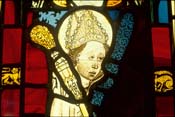William Melton facts for kids
Quick facts for kids William Melton |
|
|---|---|
| Archbishop of York | |

William Melton
|
|
| Elected | December 1315 |
| Enthroned | unknown |
| Reign ended | 5 April 1340 |
| Predecessor | William Greenfield |
| Successor | William Zouche |
| Other posts | Provost of Beverley |
| Orders | |
| Consecration | September 1317 |
| Personal details | |
| Died | 5 April 1340 Cawood Palace |
| Buried | York Minster |
| Denomination | Roman Catholic |
William Melton was an important leader in the church who lived a long time ago. He was the 43rd Archbishop of York, serving from 1317 until he passed away on April 5, 1340. An Archbishop is a very high-ranking bishop in the Christian church.
Contents
Early Life and Career
William Melton was born in a place called Melton, near Kingston upon Hull. His father was Nicholas of Melton. William also had two brothers, Henry and John.
Melton was a very busy person with many important jobs. When Edward II became king in 1307, Melton was the `Controller of the Wardrobe`. This job meant he managed the king's household expenses.
He also held several church positions at the same time. He was the `Archdeacon of Barnstaple` and the `Provost of Beverley`. A provost is a senior church official.
From 1307 to about 1312, Melton was the `Lord Privy Seal`. This was a key government role. He was also the `Dean of St. Martin's-le-Grand`. Later, from 1314 to 1316, he became the `Keeper of the Household Wardrobe`.
Becoming Archbishop of York
In December 1315, the church leaders in York chose Melton to be their next Archbishop. This happened soon after the previous Archbishop, William Greenfield, died.
However, there were some problems, and it took a while for him to officially become Archbishop. He was finally made Archbishop in September 1317. This special ceremony took place in Avignon, France, led by Pope John XXII.
While he was Archbishop, Melton had to deal with various issues. For example, he handled cases involving nuns who left their Benedictine nunnery at St Clement's by York.
Challenges and Conflicts
During Melton's time as Archbishop, there were many challenges. One big issue was the ongoing conflict with Scotland. Between 1318 and 1322, Scottish armies often raided Yorkshire. They caused a lot of damage, destroying churches and taking goods from rich monasteries.
Defending York from Scottish Raids
These raids led to a disagreement between the City of York and Archbishop Melton. They argued about who was responsible for fixing parts of the city's defenses. These defenses included a type of castle called a `motte and bailey`.
In 1319, the King and most of his trained soldiers were away fighting at the siege of Berwick. Archbishop Melton had to gather his own men to fight the Scots. He led a group of clergy, friars, and citizens from York.
This led to the Battle of Myton on October 12, 1319. The English forces, led by Melton, were completely defeated. Many clergy members died, especially while trying to swim across the River Swale to escape. Because of this, the Scots called it the `Chapter of Myton`.
Queen Isabella was in York at the time of the battle. She managed to escape safely to Nottingham.
Political Role and Royal Relations
In 1322, another battle happened, the battle of Boroughbridge. Here, Thomas, 2nd Earl of Lancaster, a powerful noble, was captured. He was then taken to his castle and executed.
Archbishop Melton had supported Lancaster at one point. This caused him to lose some favor with King Edward II. However, by 1325, he had regained the King's trust. He then became the `Lord Treasurer of England`, a very important financial role, until 1326.
Melton remained loyal to Edward II even when the King faced difficulties. He was not happy about Edward II's imprisonment. He also did not attend the coronation of the new king, Edward III. It was even said that Melton was involved in a plan to challenge the new government, which led to his arrest, but he was later found innocent.
In January 1328, Archbishop Melton performed the marriage ceremony for the young King Edward III and Philippa of Hainault. In 1330, he was again appointed Treasurer but left the position in 1331.
Building Projects and Legacy
Archbishop Melton played a big part in completing the nave of York Minster. The nave is the main part of a large church. You can still see his image above the great western entrance of the Minster today.
He also helped a lot with building St. Patrick's Church, Patrington. He gave much money towards the construction of Beverley Minster as well.
Melton passed away on April 5, 1340, at Cawood Palace. He was buried in the north aisle of the nave at York Minster. A special window was made to remember him. This window was later moved to St James' Church, High Melton in the 1790s.
When Melton died, he was very wealthy. He owned many estates and properties. His nephew, William Melton, inherited his wealth. This nephew became the ancestor of a powerful family of knights in Yorkshire.
Archbishop Melton kept detailed records of his work. These records were later published in five books called The Register of William Melton.
See also

